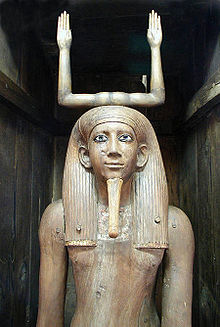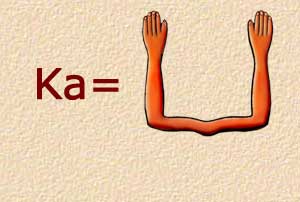Johann: Психонализ
Для защиты сервера от хакеров иногда делают honeypot. Он «проблемно» эмулирует север для того чтобы изучить собственные изъяны для таких атак чтобы им противостоять/подменить его на свою проблемную копию и, тем самым сбить с толку, а заодно и изучить методы хака.
В Др. Египте у человека было понятие о «двойнике» ( ka/kha) которые может существовать в в физически непрерывном абсолютном потоке времени без инвариатности сценариев развития событий. Он родился в том же момент, что и ты, просто ( аналогия с «Эффектом бабочки» Р. Брэдбери) в какой-то момент N ушел в иной из тысячу сценариев пространственно временного континуума и продолжал существовать при таком развития событий. После смерти, индивидуальная сущность человека (ba) может увидеть сразу все сценарии и соответствующее им количество ka для каждого — хорошего или плохого. Не так плохо.
Символический двойник

Иероглиф двойника в виде поднятых рук. Очень наглядно, ибо здесь руки как знак предполагают и «действие» (изображение руки) и двойника (поднятые вверх) - знак
утверждения/приветствия/констатации. Знак эмуляции твоего «я».

Изображением двойника можно манипулировать для обмана в потустороннем мире, дабы внушить змею при пересечении реки забвения что он ( двойник) — это ты, а ты - он. Древний honeypot. Ибо shapti - микро-эмуляция «я» по знаковому принципу.
Эдгар По в «Вильяме Вильсоне» обыгрывает мысль проблемного двойника — мистической фигуры которая подменяла героя во внешнем облике и «эмулировала» его поведение с негативной стороны…
В Др. Египте у человека было понятие о «двойнике» ( ka/kha) которые может существовать в в физически непрерывном абсолютном потоке времени без инвариатности сценариев развития событий. Он родился в том же момент, что и ты, просто ( аналогия с «Эффектом бабочки» Р. Брэдбери) в какой-то момент N ушел в иной из тысячу сценариев пространственно временного континуума и продолжал существовать при таком развития событий. После смерти, индивидуальная сущность человека (ba) может увидеть сразу все сценарии и соответствующее им количество ka для каждого — хорошего или плохого. Не так плохо.
Символический двойник

Иероглиф двойника в виде поднятых рук. Очень наглядно, ибо здесь руки как знак предполагают и «действие» (изображение руки) и двойника (поднятые вверх) - знак
утверждения/приветствия/констатации. Знак эмуляции твоего «я».

Изображением двойника можно манипулировать для обмана в потустороннем мире, дабы внушить змею при пересечении реки забвения что он ( двойник) — это ты, а ты - он. Древний honeypot. Ибо shapti - микро-эмуляция «я» по знаковому принципу.
Эдгар По в «Вильяме Вильсоне» обыгрывает мысль проблемного двойника — мистической фигуры которая подменяла героя во внешнем облике и «эмулировала» его поведение с негативной стороны…
Seeing lot of antiquity lovers and historical clubs & societies, you cannot divest yourself of the idea that pretty many of them is a pure entertainment like outdoor video RPG or cult movie parties, or the same like Venetian masquerade than a real educative immersion into any epoch, events and historical personalities connected to those. At least it seems so.
The key in this seems to be:
1/ Uniform and fashion style, generally
2/ Weapon
3/ Artefacts
4/ Historical environment - landscape and architecture
The first item is considerable. The uniform or, more broadly, historical fashion style is a strong and tempting attractor. It got its magic: can construe someone’s identity "anew", at least provisionally "anew".
For some people particular clothes bear fetish arousal context that can effectively help overcome diffidence, so it may effect doubly…
In fact, things like garments and masks destined to psychologically «update» someone’s personality. Mask is to hide your visible identity through concealing your face ( outer identity marker) while your I-ness or true ego is the same. The garments, - especially historical ones or a uniform - on the contrary, channeling your ego ( inner identity) into alter-ego while your visible identity (face) stays recognizable. This is remarkable.
Before the game, someone’s ego might be weakened by everyday routine and oppressive information flow, so it is a good way to immerse into imaginative personality of the past, to play and to feel like an actor, shrugging off media-forced fashion or lifestyle patterns. Then game is over, he or she goes back to one’s true «I». Quite Shakespearian.
What’s the use to imitate the past. Good question.
J.G. Frazer in «The Golden Bough: A Study in Magic and Religion» highlighted the phenomenon of human psyche as constantly «gold age» striving, traced in rites or mythologies of the past in order to fight the awareness of human self-inferiority - those are believed to be a source of archetypal perfection for nations and races (or a single person) that feel need to be better, in spiritual context.
In addition to this, there is an ancient collateral evidence – sceptical, yet wise and stating – the fact of the past that pretty often was regarded as a source for being improved to «psyche» or I-ness.
Book of Ecclesiastes, Chapter 7.10:
Say not thou, What is the cause that the former days were better
than these? for thou dost not enquire wisely concerning this.
So the past as a source of both inspirational and spiritual reinforcement, is very attractive.
Psychologically, the difference between ancient rites ("of passage " or ordinary) or historical events of the past – and those staged at historical clubs rallies is that the first directed to one’s personal ego, which is true, stable and constant - whereas the second addressed to one’s alter-ego that imaginative, fictional and non-inherent to the personality except only as applicable in the «game mode».
Numerous video games - historical strategies and RPGs simulating the past - are, metaphorically, lower, economy class of «deep immersion into the past»: they are more affordable, less expensive and less trust-worthy due to fantasy and possible biases of script writers, as compared to real live staging performed by historical clubs & societies, which might be named as «business class».
The thing above can explain the difference in perceiving and evaluation the same event – f.e. WW II rally – by any of modern not already politically biased participants born after 70s - and an aged veteran invited as a guest, who was a real participant in those historical events. The latter – as far as I had heard it from his interview – felt something like cognitive dissonance when he observed people dressed exactly as nazi SS soldiers and those as allies soldiers speaking, joking, launching, drinking together. For him the uniform firstly is an accurate enemy marker – the enemy who many years ago had killed his pals and committed atrocities that he could see with his own eyes.
The key in this seems to be:
1/ Uniform and fashion style, generally
2/ Weapon
3/ Artefacts
4/ Historical environment - landscape and architecture
The first item is considerable. The uniform or, more broadly, historical fashion style is a strong and tempting attractor. It got its magic: can construe someone’s identity "anew", at least provisionally "anew".
For some people particular clothes bear fetish arousal context that can effectively help overcome diffidence, so it may effect doubly…
In fact, things like garments and masks destined to psychologically «update» someone’s personality. Mask is to hide your visible identity through concealing your face ( outer identity marker) while your I-ness or true ego is the same. The garments, - especially historical ones or a uniform - on the contrary, channeling your ego ( inner identity) into alter-ego while your visible identity (face) stays recognizable. This is remarkable.
Before the game, someone’s ego might be weakened by everyday routine and oppressive information flow, so it is a good way to immerse into imaginative personality of the past, to play and to feel like an actor, shrugging off media-forced fashion or lifestyle patterns. Then game is over, he or she goes back to one’s true «I». Quite Shakespearian.
What’s the use to imitate the past. Good question.
J.G. Frazer in «The Golden Bough: A Study in Magic and Religion» highlighted the phenomenon of human psyche as constantly «gold age» striving, traced in rites or mythologies of the past in order to fight the awareness of human self-inferiority - those are believed to be a source of archetypal perfection for nations and races (or a single person) that feel need to be better, in spiritual context.
In addition to this, there is an ancient collateral evidence – sceptical, yet wise and stating – the fact of the past that pretty often was regarded as a source for being improved to «psyche» or I-ness.
Book of Ecclesiastes, Chapter 7.10:
Say not thou, What is the cause that the former days were better
than these? for thou dost not enquire wisely concerning this.
So the past as a source of both inspirational and spiritual reinforcement, is very attractive.
Psychologically, the difference between ancient rites ("of passage " or ordinary) or historical events of the past – and those staged at historical clubs rallies is that the first directed to one’s personal ego, which is true, stable and constant - whereas the second addressed to one’s alter-ego that imaginative, fictional and non-inherent to the personality except only as applicable in the «game mode».
Numerous video games - historical strategies and RPGs simulating the past - are, metaphorically, lower, economy class of «deep immersion into the past»: they are more affordable, less expensive and less trust-worthy due to fantasy and possible biases of script writers, as compared to real live staging performed by historical clubs & societies, which might be named as «business class».
The thing above can explain the difference in perceiving and evaluation the same event – f.e. WW II rally – by any of modern not already politically biased participants born after 70s - and an aged veteran invited as a guest, who was a real participant in those historical events. The latter – as far as I had heard it from his interview – felt something like cognitive dissonance when he observed people dressed exactly as nazi SS soldiers and those as allies soldiers speaking, joking, launching, drinking together. For him the uniform firstly is an accurate enemy marker – the enemy who many years ago had killed his pals and committed atrocities that he could see with his own eyes.
